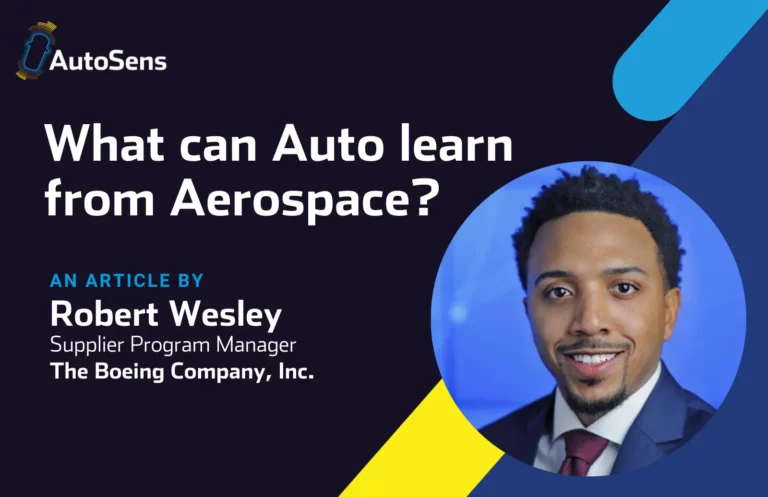by Robert Stead, Managing Director of Sense Media, organisers of AutoSens
Another stellar AutoSens draws to a close. Twelve months of build-up consigned to the past, but we relish in the fruits of our labour living on for far longer. AutoSens has gone from strength to strength with its return to Brussels, delivering another “best in class” conference for 550 of the most skilled engineers and technologists in the automotive industry. AutoSens has become far more than I could have ever imagined in just three years, it’s humbling to hear attendees speak of the event with such enthusiasm and passion, all thrilled at the thought of taking away an abundance of inspiration and motivation for the next steps. Here are my thoughts on what we learned…
Sensors are pretty good but ADAS systems are complex and there is still a lot to learn and challenges to overcome. On show throughout the exhibition floor we had an impressive range of sensor technologies. Image sensor vendors continue to refine and improve their products to best adapt cameras to automotive applications. Radar is going through somewhat of a resurgence, with lots of innovation and newer, high resolution offerings, and you don’t need me to tell you it’s booming in LiDAR!
But ADAS at system level is complex, and we still don’t know the optimum mix of sensor modes, we haven’t yet decided which approach to system architecture holds the key to low power and high performance in the harsh automotive operating environment. There are great minds on all sides of a polygonal fence on that, which for me is exciting, because there’s still lots to discuss and learn.
Through academic research, applied research, and corporate R&D we learn more each week about how best to design, tune, and deploy vehicle perception systems, what’s for sure is that further innovation in sensors and processors will give systems designers more flexible tools to use, and reduce some of the pressures on the system. This is an exciting area of technical research, and I think we all know the best solutions lie with a mix of sensors, and system designs tuned to the application.
Testing is pretty good, but safety and validation have to be the top priority. Never a day goes by that I don’t see multiple posts on LinkedIn questioning the safety of the current testing regimes, some of these are well grounded, and some are fuelled by the writer’s own strong beliefs on what’s right and wrong. Also to be said here is that we have a lot to learn about how we can fully validate vehicles, and what thresholds will be acceptable to regulators, manufacturers, and the market.
There’s some incredible innovation to be seen in simulation, testing and validation, and throughout the AutoSens community I see the whole supply chain placing the highest value on safety and robust system design, which is hugely encouraging. Nobody is taking a blasé approach to this, despite what you might read in the press, which tells me that we’ll get to where we need to. The solution is not one single thing, it’s about building redundancy into the design, building quality and consistency into the components, making the most of virtual testing environments, conducting real world tests in the safest possible way, and finally, accepting the risks – I personally don’t believe it’s possible to achieve 0% accidents, the world is too complex, but that doesn’t mean we can’t aspire to that goal.
We need to understand people’s interactions better both in terms of direct HMI, but also in traffic situations. People are the most complex part of the transport system, and we aren’t ever going to remove them from the equation. Even in the distant future when we have 100% driverless vehicles, we are still transporting people, they have to interact with the system, and there will always be unpredictable situations. So we must invest the time and effort to understanding human factors in parallel with automated systems.
Varied scientific disciplines are required to solving these problems. It’s not just electronics, we need input from psychologists, biologists, physicists, economists, environmental scientists and more to tackle these challenges from enough different perspectives to be thorough. If we get buried in building perfect robots for a perfect environment we are missing the point. But as well as these requirements for cross-disciplinary collaboration, we need to attract more bright minds to a career in the automotive space to achieve all of the above. Everyone in the AutoSens community should be playing a part in promoting STEM education, supporting girls and women in engineering, and portraying automotive as the exciting, fast moving, society-impacting industry it is. If you are not, now is the time to find out what’s going on in your area, or even start a new initiative yourself.
The market is in flux and the path is not set… indeed theses are changing times, we say it every year but the automotive sector is in the middle of a revolution. We don’t know which technologies will win out, we don’t know how fast autonomous vehicles will be adopted. But those unknowns aren’t to be feared, as they bring opportunity. This is the best time in decades to be employed in this sector, so we should all be excited about the future.
AutoSens will continue to bring the community together to learn, collaborate, inspire and recognise achievement. Where are we on the Gartner Hype curve? As was mentioned in the closing plenary, perhaps we are just over the peak, but we are well short of the trough of disillusionment. No matter what lies ahead, AutoSens will remain as a platform to support engineers and scientists to pursue the development of best in class technology.
Thank you to everyone involved in making it happen – my team, speakers, workshop leaders, panellists, chairs, advisory board, sponsors, exhibitors, delegates, venue and onsite staff, and all the crazy nerds whose passion and drive makes technology possible!
See you in Detroit!







